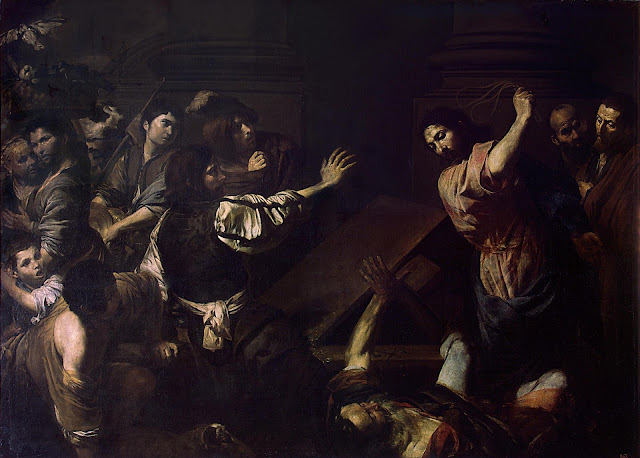 |
| Valentin de Boulogne Expulsion of the Money-changers ca. 1618 oil on canvas Palazzo Barberini, Rome |
 |
| Valentin de Boulogne Expulsion of the Money-changers ca. 1620-25 oil on canvas Hermitage, Saint Petersburg |
 |
| Valentin de Boulogne Soldiers playing Cards and Dice ca. 1618-20 oil on canvas National Gallery of Art, Washington DC |
"Little is known of Valentin de Boulogne's short but influential career, except that he had moved to Rome by 1614. He may have studied with Simon Vouet, and he was profoundly influenced by the realism of the art of Caravaggio and his followers. He was Nicolas Poussin's friend; the two young Frenchmen may have met for the first time in Rome, the artistic mecca and crossroads of all classes and nationalities. De Boulogne's only documented work [Martyrdom of St Processus and St Martinian, 1627-28, directly below] hung in Saint Peter's Basilica next to Poussin's only public picture in Rome. Both men painted religious and secular compositions for private patrons, but their art could not have been more different. Poussin's approach was intellectual: he insisted on harmony in his compositions, and he painted the ideal and the abstract. De Boulogne's approach, on the other hand, was personal and dramatic. He infused his pictures with melancholy, even sadness. His genre scenes captured the seedy, coarse aspects of life, much of which he probably experienced in the rough melting pot that was Rome."
– from biographical sketch by curators at the Getty Museum
 |
| Valentin de Boulogne Martyrdom of St Processus and St Martinian 1629 oil on canvas Pinacoteca Vaticana, Rome |
 |
| Valentin de Boulogne Fortune Teller 1620 oil on canvas Toledo Museum of Art (Ohio) |
 |
| Valentin de Boulogne Christ and the Woman taken in Adultery ca. 1620 oil on canvas Getty Museum, Los Angeles |
 |
| Valentin de Boulogne David with the Head of Goliath ca. 1620-22 oil on canvas Museo Thyssen-Bornemisza, Madrid |
 |
| Valentin de Boulogne Martyrdom of St Lawrence ca. 1622-24 oil on canvas Museo del Prado, Madrid |
"Valentin differs from Bartolomeo Manfredi in his more taut and energetic draftsmanship, in his greater skill in composition and in his sensitive, almost nervous psychological intensity, qualities which he unfortunately all too often carried to the point of exaggeration. He was by preference a painter of secular scenes, but he also understood how to advance from these to more dramatic and meaningful subjects. In his use of color one senses a rather unpleasant dryness and monotony, especially in the lifeless flesh tones. Now and again he attempts a stronger chromatic harmony which, despite the intensity, remains curiously cold because he tends to neutralize his hues by adding dull gray-blues and olive-grays."
– Hermann Voss, from Baroque Painting in Rome (1925), revised and translated by Thomas Pelzel (San Francisco: Alan Wofsy, 1997)
 |
| Valentin de Boulogne Judith with the Head of Holofernes ca. 1625 oil on canvas Musée des Augustins de Toulouse |
 |
| Valentin de Boulogne Lute Player ca. 1625-26 oil on canvas Metropolitan Museum of Art, New York |
 |
| Valentin de Boulogne Musical Party ca. 1626 oil on canvas Los Angeles County Museum of Art |
 |
| Valentin de Boulogne Allegory of Italy ca. 1627-28 oil on canvas Villa Lante al Gianicolo, Rome |
 |
| Valentin de Boulogne The Four Ages of Man ca. 1629 oil on canvas National Gallery, London |
 |
| Valentin de Boulogne Portrait of Rafaello Menicucci ca. 1630-32 oil on canvas Indianapolis Museum of Art |
"Only one vivid anecdote pertaining to Valentin has come down to us, one which significantly has linked his name forevermore with his low life tavern scenes. Recounting the artist's early death in 1632, Giovanni Baglione wrote that Valentin passed a night in a tavern during the heat of the summer. The great quantity of tobacco and excess of wine he consumed produced within him an overwhelming internal heat. On passing the Fontana del Babuino, Valentin leaped in, hoping to cool himself down. The cold water only consolidated the heat and he contracted a terrible fever, from which he died in a few days. Valentin left no money to cover the costs of an honorable funeral, but he was laid to rest at the expense of the great encyclopedic collector and member of Cardinal Francesco Barberini's household, Cassiano dal Pozzo (1588-1657), whose features Valentin recorded in a now-lost portrait."
– excerpted from the artist's biography in the Systematic Catalogue of the National Gallery of Art, Washington DC